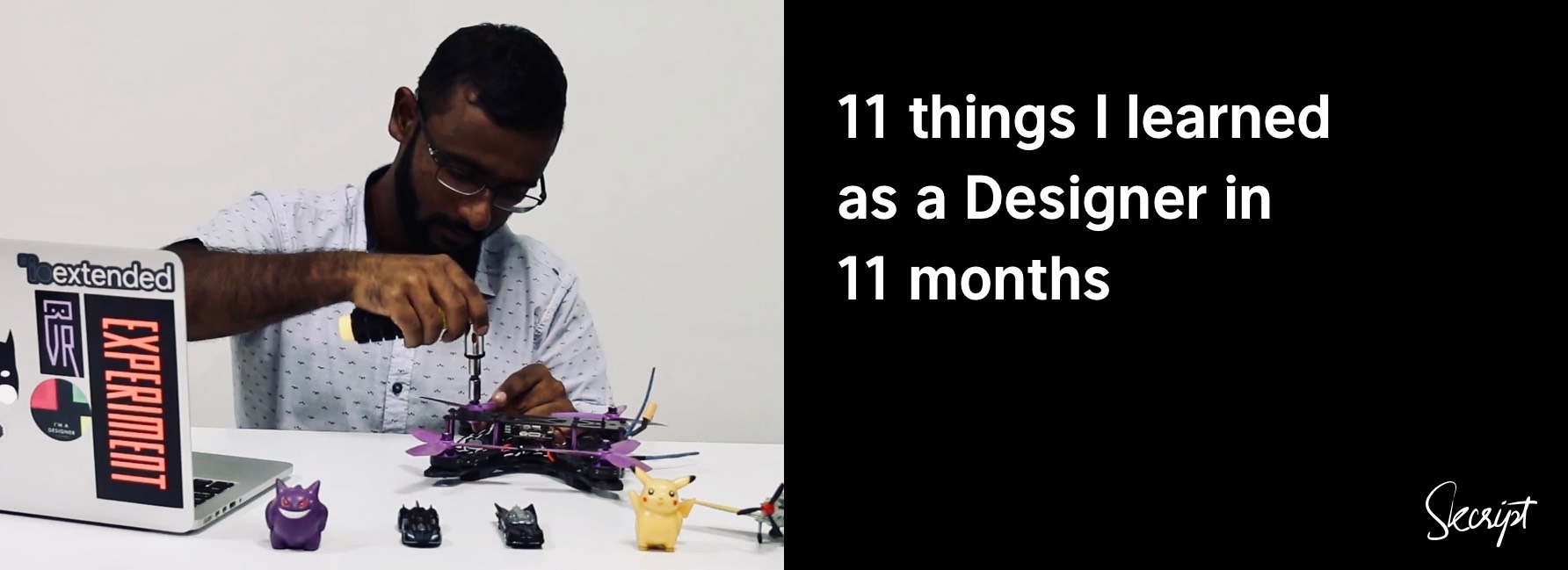11 things I learned as Designer in 11 months
The trials and triumphs of a self-taught designer. This might even be your story too - why don’t you read and find out.
Subscribe to our awesome Newsletter.

A little back story
It’s been almost a year (11 months to be exact) since I joined hands with the extremely passionate and exuberant people of Skcript to work as a Designer. I have learnt something new every single day for the past 334 days which has improved my skill as a designer and made me a better person as well.
This is about the 11 things I learned as a designer in the past 11 months.
Always keep learning
There are two ways in which you can learn - by practice or by reading something new and applying that. Design is something that requires both. When I started my design career, I absolutely had no clue on what design was or how to even start. That’s when I came across this gem of a book by Jesse James Garrett called The Elements of User Experience. Apart from this the UX & Web Design Master Course by Joe Natoli was brilliant as well!
Whenever you feel the work you produce is getting repetitive and boring, that’s when you realize that you are sitting in your comfort zone. To break that, it’s time to challenge yourself to learn something new every day to push your own boundaries. You can try the Daily UI Challenge for a start.
Listen Actively
There’s a saying that you should always listen more than you speak. This is especially true during the very first engagement with any client. As designers, it’s our duty to solve their problems with design. Listening actively will not only help us empathize with them, but also aid in understanding the problem we’re solving. This will also help us drive the conversation in such a way that we’ll be able to ask insightful questions.
Observe Carefully
While conducting User Interviews to understand the problems faced by the target audience, the people with whom we’re having the conversation with wouldn’t be able to explicitly express their pain points or the troubles they may be having with the existing solutions they use. This is where we should carefully observe their body language and other non-verbal methods of communication will help us truly understand what they are going through.
Explore bravely
Design is a very vast field. There is graphic design, UI/UX design, motion design, logo design, typography et al. With this many sub categories in design, it’s important that you dip your feet in some of it to explore if that’s a niche in which you would want to be an expert in. Only when you give it a shot in the various sub categories, you’ll be able to find in which one you want to be an expert in. For instance, I’m more into UI/UX as emphasizing with users comes pretty natural to me. So, explore and see what suits you the best.
Creativity isn’t rocket science
Creativity may seem something that is very complicated and unfathomable but it really isn’t. It’s very similar to cooking food. When you’re learning to cook you throw in different ingredients in various proportions and pray to God that it comes out well. Creativity is just like that. Instead of ingredients, you put in different elements of design that you found inspiring from other peoples’ work. But, there’s a very fine line between creativity and down right stealing. You should be able to put in various elements from different sources of inspirations to create something new. That’s creativity.
Empathy aka the Design Buzzword
When I first heard the word empathy, I thought it was something related to medicine like Homeopathy, Allopathy but apparently it’s a word that describes your ability to understand the feelings of another person! It may seem difficult to comprehend empathy but I learned that it’s extremely simple. In order to empathize with another human being, it’s mandatory to actively listen to them, observe carefully how their non-verbal communication like gestures, body language et al is taking place, which will eventually help you feel what the other person is going through.
Understanding Business
Designing is primarily problem solving. When you attempt to solve these problems, there are User Goals, which is focused towards the potential users of the application and Business Goals, which is the goals of the stakeholders primarily focused towards gaining monetary benefits from the problem they’re hiring you to solve. Thus, understanding the business is crucial to designing an application that will satisfy the business goals.
Follow a design process
The Human Centered Design Process that we follow will help to streamline your thoughts into separate chunks so that we will systematically uncover insights that will eventually enable us to design a functional UI for the problem that we are trying to solve.
You can’t create colors
Choosing colors is one of the most challenging aspects of design. Using the color wheel in Sketch or Illustrator to magically come up with a color palette with matching colors isn’t possible. That’s where resources like Dribbble, Coolors, and Adobe Colors will be very handy.
Communication is key
There’s a popular saying in the design world that UI design is like a joke. If you have to explain it, it isn’t good enough. Although the user should be able to understand the purpose of the design, it is also the duty of the designer to use proper language, suitable icons that serve their purpose, proper colors that communicate the apt intention (like green is for something positive and red is for something negative). Apart from verbal communication, visual communication is key in design.
Workplace matters. A lot.
Your workplace is literally your second home. After all, you spend the majority of your day at work. A positive work environment will help in improving productivity, focus, and nurture creativity.
And that’s how my design journey goes!
